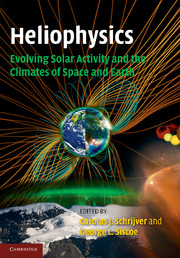Book contents
- Frontmatter
- Contents
- Preface
- 1 Interconnectedness in heliophysics
- 2 Long-term evolution of magnetic activity of Sun-like stars
- 3 Formation and early evolution of stars and protoplanetary disks
- 4 Planetary habitability on astronomical time scales
- 5 Solar internal flows and dynamo action
- 6 Modeling solar and stellar dynamos
- 7 Planetary fields and dynamos
- 8 The structure and evolution of the three-dimensional solar wind
- 9 The heliosphere and cosmic rays
- 10 Solar spectral irradiance: measurements and models
- 11 Astrophysical influences on planetary climate systems
- 12 Assessing the Sun–climate relationship in paleoclimate records
- 13 Terrestrial ionospheres
- 14 Long-term evolution of the geospace climate
- 15 Waves and transport processes in atmospheres and oceans
- 16 Solar variability, climate, and atmospheric photochemistry
- Appendix I Authors and editors
- List of illustrations
- List of tables
- References
- Index
- Plates
14 - Long-term evolution of the geospace climate
Published online by Cambridge University Press: 05 April 2013
- Frontmatter
- Contents
- Preface
- 1 Interconnectedness in heliophysics
- 2 Long-term evolution of magnetic activity of Sun-like stars
- 3 Formation and early evolution of stars and protoplanetary disks
- 4 Planetary habitability on astronomical time scales
- 5 Solar internal flows and dynamo action
- 6 Modeling solar and stellar dynamos
- 7 Planetary fields and dynamos
- 8 The structure and evolution of the three-dimensional solar wind
- 9 The heliosphere and cosmic rays
- 10 Solar spectral irradiance: measurements and models
- 11 Astrophysical influences on planetary climate systems
- 12 Assessing the Sun–climate relationship in paleoclimate records
- 13 Terrestrial ionospheres
- 14 Long-term evolution of the geospace climate
- 15 Waves and transport processes in atmospheres and oceans
- 16 Solar variability, climate, and atmospheric photochemistry
- Appendix I Authors and editors
- List of illustrations
- List of tables
- References
- Index
- Plates
Summary
Introduction
Our understanding of the prehistory of geospace is largely addressed by a series of “what if” scenarios or thought experiments. Hence, this chapter will appear more qualitative than many of the other chapters. As the thought experiments will primarily be based on knowledge of the geospace presented quantitatively in other chapters, these chapters are referenced as the thought experiments are performed. Having freed ourselves from mathematical rigor, we can step backwards into earlier times. As we shall see, it is quite surprising that mankind's earliest records of the cosmos also detail geospace events. Geospace is a very modern term and represents the assimilation of knowledge gained by modern technologies, radio transmitters and receivers, optical and laser systems, and rocket and satellite instruments, whose measurements were made inside geospace. However, prior to this technological momentum of the last century, mankind was aware of geospace phenomena via observations of aurorae, sunspots, solar flares, magnetometer deflections, induced currents in telegraph lines, etc. (see also Vol. II, Chapter 2). This chapter begins by exploring the extent of this human awareness from a geospace climate perspective.
My own introduction to these phenomena occurred while I was a Scottish schoolboy in the Borders town of Gordon. As a 6-year old at a Christmas party on a cold, dark December afternoon, I heard a rendition of the song “The Northern Lights of Old Aberdeen”, the lyrics of which were written by Mel and Mary Webb in 1952.
- Type
- Chapter
- Information
- Publisher: Cambridge University PressPrint publication year: 2010



